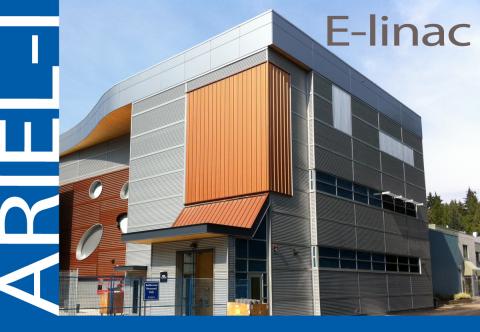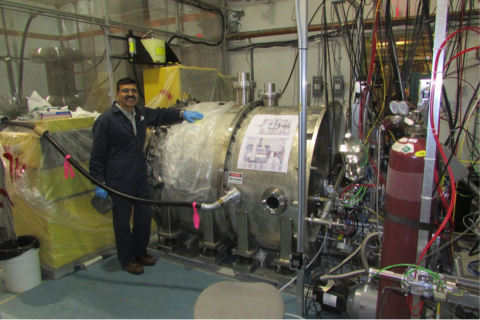

Last week, three crucial events in the assembly of TRIUMF’s new electron linear accelerator (e-linac) were completed. First, the cold-box for the accelerating cavities passed and exceeded its acceptance test. Second, the first of the three accelerating cavities has met specifications, and third, the electron source for the e-linac has passed its tests as well. As part of TRIUMF’s Five-Year Plan, the e-linac is a crucial component of the ARIEL project that will expand Canada's capabilities to produce and study isotopes for physics and medicine.
The e-linac uses superconducting niobium cavity technology to accelerate electrons up to 30 MeV. To reach such high energies an enormous amount of precision is required in the equipment used. The cavities must pass several tests to ensure that the waves that accelerate the electron reach a quality factor of 1010. (In comparison, the sound waves from tuning forks have a quality factor of only a few hundred.) As of November 29th, the first cavity passed its tests and is ready for installation. These are the first superconducting cavities of this type to be designed and built in Canada.
For key performance, the cavity must be kept at a very low temperature: -271 degrees Celsius or 2 Kelvin. The machine primarily responsible for cooling the cavity is called the cold-box and it holds liquid helium at a chilly -269 degrees Celsius. At such extreme temperatures careful measures must be taken by TRIUMF engineers to ensure that equipment does not malfunction. On November 28th the cold-box passed three different tests where it exceeded expectations. Bringing the ARIEL team one big step closer to completing the cryogenic system of the e-linac.
The e-linac would be nothing without its source of electrons which spring from the electron gun. The electron gun creates and energizes a source of electrons to 300 KeV –the precise speed required for the accelerator. If the electrons do not accelerate fast enough they bounce off the accelerator, but if they accelerate too fast then they will miss the accelerating wave and get thrown out of the accelerator. Based on the tests last week, the TRIUMF team is entirely confident that the electron gun is capable of achieving the energy required to create a steady beam of electrons for the accelerator.
We are incredibly proud of everyone in the accelerator division who has put long hard hours into making these developments and the ones to come a reality. Congratulations!
Photo: Naimat Khan at the e-linac electron source.
–Gabe Baron, Outreach Assistant
